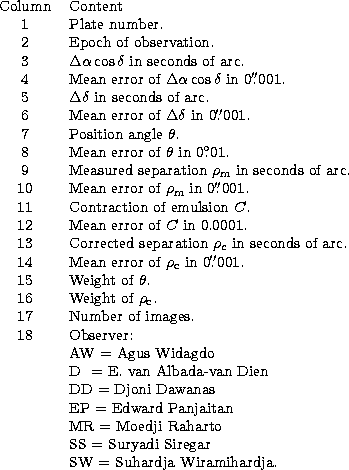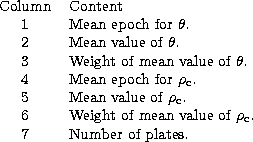The reductions were carried out on the basis of a plate scale of
![]() . We found the coefficient of contraction of the emulsion of
the plates in this series of observations is
. We found the coefficient of contraction of the emulsion of
the plates in this series of observations is ![]() (mean of
mean errors) for those taken with full diaphragm and
(mean of
mean errors) for those taken with full diaphragm and ![]() for plates taken with the hexagonal aperture. Coefficients stated above
indicate that there is an insignificant contraction effect.
for plates taken with the hexagonal aperture. Coefficients stated above
indicate that there is an insignificant contraction effect.
In order to find the asymmetry on diffraction pattern, the averaged first
order images of the primary were compared with the direct measurement of
Sirius A. In each set of the two measurements, we found the same case with that
discovered by van Albada-van Dien (1977). The difference is always in the same
direction, namely, the averaged first diffraction image is always to the north
of Sirius A (with a mean displacement of ![]() to the
north). However, this systematic displacement does not hold for plates taken
with hexagonal aperture. For these plates, the difference is always to the
north for one position (with trail below the images), and to the south for the
other position (trail above the images after a
to the
north). However, this systematic displacement does not hold for plates taken
with hexagonal aperture. For these plates, the difference is always to the
north for one position (with trail below the images), and to the south for the
other position (trail above the images after a ![]() rotation). The
mean value to the north is
rotation). The
mean value to the north is ![]()
![]() , and the mean value to
the south is
, and the mean value to
the south is ![]() . Contrary to what was detected by
van Albada-van Dien (1977), we do not find the tendency to east or west
displacements, nor the same direction of displacements in series of plates
taken in succession is found.
. Contrary to what was detected by
van Albada-van Dien (1977), we do not find the tendency to east or west
displacements, nor the same direction of displacements in series of plates
taken in succession is found.
The observations were weighted with the inverse square of the mean error,
without another addition for plate or night errors. Weight 1 was attributed to
a mean error of ![]() in
in ![]() and of
and of ![]() radians in
radians in ![]() . For fair quality plates, we often could not measure the
first and/or the second diffraction images. For these kind of plates, the
contraction of emulsion was not defined, and therefore weights could not be
assigned.
. For fair quality plates, we often could not measure the
first and/or the second diffraction images. For these kind of plates, the
contraction of emulsion was not defined, and therefore weights could not be
assigned.
The results of the reductions appear in Table 1, which consists of:

Table 2 yields the yearly means. Only plates with weights were
included, except for those taken in 1983 which have no weights.

We are still investigating the systematic errors which might come from the
geometric effect. In the future, we propose that further photographic
measurements are carried out in order to study the effect.
Acknowledgements
The authors would like to express their sincerest gratitude to the Director of Leids Kerkhoven-Bosscha Fonds for the generous support on the research of double stars at the Bosscha Observatory. They also acknowledge Dr. E. van Albada-van Dien and Dr. Taufiq Hidayat for the suggestions and fruitful discussions, and Edy Susilo for measuring the plates.
Copyright The European Southern Observatory (ESO)